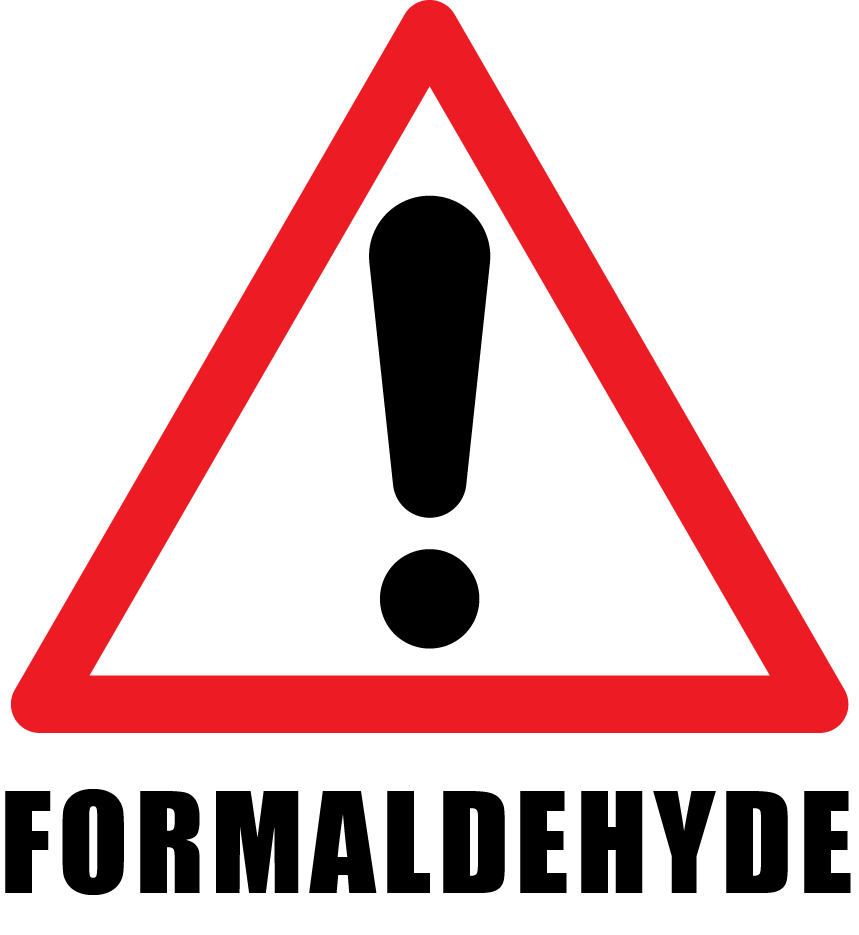The word “formaldehyde” may immediately trigger thoughts an awful smell wafting through the air on frog dissection day. The compound is commonly used in medical settings as a preservative, but what is it, exactly?
Formaldehyde is a colorless, pungent, flammable, naturally occurring volatile compound that most living things produce as part of their metabolic processes; it has even been identified as an organic byproduct of wood decomposition and combustion. Aside from its presence in the natural environment, formaldehyde is also manufactured in large quantities for use as a binding agent in a large variety of consumer products. Even though formaldehyde is all around us and may not be something thought of as “dangerous,” excessive exposure to the compound can cause adverse health affects that can be a concern in both residential and occupational settings. Read on to get a better idea of what kind of products formaldehyde can be found in, what problems it can cause, and health concerns that can arise.
Potential Sources of Formaldehyde Emissions in Buildings
As industrial binder, urea-formaldehyde has been used in a large number of building and consumer products. Potential sources of formaldehyde emissions within buildings include:
[su_heading size=”18″ align=”left”]Building Materials[/su_heading]
1. Particle board
2. Mineral wool and fiberglass insulation
3. Vapor barrier material
4. PVC plumbing components
[su_heading size=”18″ align=”left”]Building finish products[/su_heading]
5. Carpeting
6. Wood and laminate flooring
7. Paint
8. Linoleum
9. Wallpaper
[su_heading size=”18″ align=”left”]Furniture[/su_heading]
10. Wood furniture
11. Upholstered furniture
[su_heading size=”18″ align=”left”]Equipment and Supplies[/su_heading]
12. Electronic equipment
13. Paper
14. Dyes
15. Inks
16. Cleaning products
17. Cosmetics
Formaldehyde Emissions
Emissions from products created with urea-formaldehyde resin occurs due to the reversibility of the chemical reaction used to form the resin, causing emissions to continue over significant periods of time. However, as the formaldehyde-containing product gets older, emission potential decreases, so measurable emissions are likely to be highest immediately following new construction, remodeling, or installation of new furniture. Emissions can vary significantly based on the presence of ozone, temperature, humidity, and light impaction.
Potential Health Impacts of Formaldehyde
According to the Agency for Substances and Disease Registry (ATSDR), potential health effects of formaldehyde exposure include nasal and eye irritation, neurological effects, and increased risk of asthma and/or allergies at exposure rates of 0.1 to 0.5 parts per million (ppm). Eczema and changes in lung function have been observed at 0.6 to 1.9 ppm. The Department of Health and Human Services has determined that formaldehyde is a known human carcinogen. There are no reliable medical tests for formaldehyde because it is produced in the body and is present as a normal constituent of tissues and fluids.
Recommended Formaldehyde Exposure Limits
Since formaldehyde has been proven to cause adverse health effects, significant epidemiological and toxicological research has been conducted to establish permissible exposure limits.
Regulatory limits and recommendations can be divided into two categories: occupational and residential exposure. Occupational limits are generally higher than residential guidelines, and are based on an assumption that exposure will be generally limited to eight hour working days, five days per week. Residential guidelines include the vulnerability of the population and the potential for exposure to lower levels over longer periods of time.
The ATSDR states that measured levels of formaldehyde in indoor air range from 0.02 to 4 ppm. Outdoor levels range from 0.0002 in rural areas to 0.02 ppm in urban areas. The following are recommended limits for formaldehyde emissions:
[su_row]
[su_column size=”2/3″]OSHA Permissible Exposure Limit (8 Hour Time Weighted Average)[/su_column]
[su_column size=”1/3″] 0.75 ppm [/su_column]
[/su_row]
[su_row]
[su_column size=”2/3″]Toxic Substances Control Act Amendment [/su_column]
[su_column size=”1/3″] 0.05 ppm [/su_column]
[/su_row]
[su_row]
[su_column size=”2/3″]NIOSH Recommended Exposure Limit (8 hour TWA)[/su_column]
[su_column size=”1/3″] 0.016 ppm [/su_column]
[/su_row]
[su_row]
[su_column size=”2/3″]FEMA Exposure Limit (8 hour TWA)[/su_column]
[su_column size=”1/3″] 0.016 ppm [/su_column]
[/su_row]
Addressing Formaldehyde Emissions
Reducing the risk of potential exposure in residential settings requires adequate ventilation and dehumidification of the indoor environment. Additionally, special care must be taken when purchasing new building products, finish materials, and furnishings. Products that meet Leadership in Energy & Environmental Design (LEED) low-emitting certification requirements or are labelled as urea-formaldehyde free can reduce potential indoor emissions. Sealing existing products with a non-formaldehyde sealant may also reduce emissions.
Indoor air contaminants can quickly become an issue in both residential and occupational settings. If you suspect any problems with your air quality, visit our website at dev.trimediaee.com.

